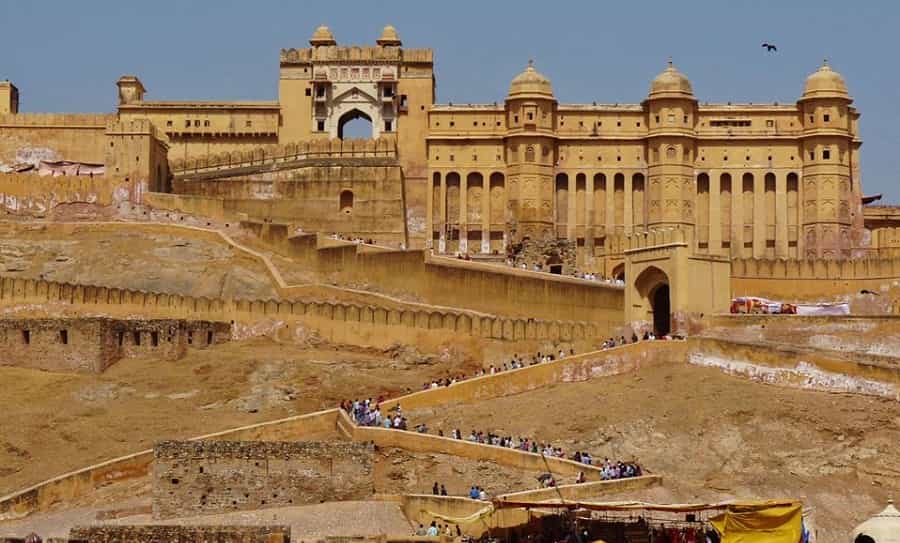Key Points
- Chittorgarh Fort is located in Chittorgarh, Rajasthan, atop a hill near the Gambheri River.
- It seems likely that the fort was built in the 7th century AD by the Maurya dynasty and later became the capital of Mewar, known for Rajput valor and jauhar.
- Research suggests the best time to visit is October to March, when the weather is cooler for exploration.
- The fort is a UNESCO World Heritage Site, with a rich history of sieges and cultural significance.
Location
Chittorgarh Fort is situated in the city of Chittorgarh, in southern Rajasthan, India, atop a 180-meter-high hill near the Gambheri River. It covers 700 acres and is accessible via a 1 km steep road leading to its main entrance, Ram Pol. The fort is approximately 233 km from Ajmer, midway between Delhi and Mumbai on National Highway 48, with coordinates at 24°53′11″N 74°38′49″E.
History

The fort, originally called Chitrakut, was likely built in the 7th century AD by King Chitrangad of the Maurya dynasty. It was captured by the Guhila ruler Bappa Rawal in 728 CE, becoming the capital of Mewar. It faced significant sieges, including:
- 1303 AD: An 8-month siege by Alauddin Khilji, leading to the first Jauhar by Rajput women, including Rani Padmini.
- 1535 AD: Bahadur Shah of Gujarat’s siege, resulting in the second Jauhar and the death of 3,200 warriors.
- 1567–1568 AD: A 4-month siege by Akbar, with a third Jauhar and the killing of 20,000–25,000 civilians.
- Returned to Rajputs in 1615 under Amar Singh after a Mughal treaty, and refurbished in 1905 during the British Raj.
It is now a UNESCO World Heritage Site, recognized in 2013 as part of the Hill Forts of Rajasthan, symbolizing Rajput valor and hosting the annual Jauhar Mela.
Best Time to Visit
The evidence leans toward visiting between October and March, when cooler weather makes exploring the vast fort complex more comfortable, given Rajasthan’s typically hot climate.
Survey Note: Comprehensive Details on Chittorgarh Fort

Chittorgarh Fort, located in the heart of Rajasthan, is a monumental testament to Rajput history, architecture, and culture. This survey note provides an exhaustive overview of its location, historical significance, and practical visiting details, ensuring a thorough understanding for travelers and historians alike.
Location and Accessibility
Chittorgarh Fort is perched atop a 180-meter-high hill in Chittorgarh, southern Rajasthan, near the Gambheri River, covering an expansive 700 acres with a circumference of 13 km and a maximum length of 5 km. Its exact location is at Chittor Fort Road, Chittorgarh, Rajasthan 31200, with coordinates 24°53′11″N 74°38′49″E. The fort is situated on the left bank of the Berach River, a tributary of the Banas River, and is linked to the new town of Chittorgarh developed post-1568 AD.
For accessibility, the fort is well-connected:
- By Air: The nearest airport is Maharana Pratap Airport in Udaipur, approximately 90–95 km away, with flights operated by SpiceJet, Air India, Jet Airways, and Indigo from cities like Delhi, Mumbai, and Kolkata (Maharana Pratap Airport).
- By Rail: Chittorgarh Junction, just 6 km from the fort, and Chanderiya, 11 km away, are well-connected to major cities like Udaipur, Jaipur, Ajmer, Ratlam, Delhi, and Kota. Notable trains include the Mewar Express and Chetak Express from Udaipur.
- By Road: Regular bus services are available from major Rajasthan cities, with distances including 200 km from Udaipur (2 hours), 300 km from Jaipur, and 312 km from Jodhpur. Taxis from Udaipur are recommended for convenience, taking about 2 hours.
The fort is accessible through a 1 km steep road leading to its main entrance, Ram Pol, one of its seven gates, ensuring visitors can reach it with relative ease.
Historical Context and Significance
Chittorgarh Fort, originally named Chitrakut, was constructed in the 7th century AD by King Chitrangad of the Maurya dynasty, though some sources suggest it was built by the Mori ruler Chitrangada Mori. It was captured by Bappa Rawal, a Guhila ruler, in 728 CE or 734 CE, marking its transformation into the capital of the Mewar kingdom. The fort’s history is marked by significant sieges and acts of valor:
- 1303 AD: Alauddin Khilji besieged the fort for 8 months, leading to the first Jauhar, where Rani Padmini, wife of Rana Ratan Singh, and other Rajput women committed self-immolation, and 30,000 Hindus were massacred.
- 1535 AD: Bahadur Shah of Gujarat attacked, resulting in the second Jauhar by 13,000 women and children, with 3,200 warriors dying in battle.
- 1567–1568 AD: Akbar’s 4-month siege led to the third Jauhar, with 20,000–25,000 civilians killed, marking a significant loss for the Rajputs.
- 1615 AD: The fort was returned to Amar Singh after a Mughal-Rajput treaty, and it was refurbished in 1905 during the British Raj.
The fort’s historical narrative is enriched by inscriptions, such as the earliest Guhila inscription from Tejasimha’s reign (mid-13th century), mentioning “Chitrakuta-maha-durga.” It is renowned for its association with Rajput valor, pride, and the practice of Jauhar, reflecting the unbending spirit of Rajput women. In 2013, it was declared a UNESCO World Heritage Site as part of the Hill Forts of Rajasthan, recognized for its cultural and historical significance under criteria ii and iii, with reference no. 247 (UNESCO Listing).
Culturally, the fort hosts the annual Jauhar Mela, commemorating the bravery and sacrifices, serving as a platform for political discourse and cultural expression. This event, held annually, underscores the fort’s enduring legacy.
Best Time to Visit and Practical Details

Given Rajasthan’s desert climate, the best time to visit Chittorgarh Fort is between October and March, when temperatures are cooler, typically ranging from 10°C to 25°C, making it ideal for exploring the vast fort complex. This period aligns with the cooler winter months, avoiding the intense heat of summer, which can exceed 40°C.
For practical visiting details:
- Timings: The fort is open from 9 am to 6 pm daily. The light and sound show, featuring the fort’s history, is available from 7 am to 8 pm, with contact details at 01472 241238 for further information.
- Entry Fees:
- Adults: Rs 50, Kids: Rs 25.
- Online ticket prices: Rs 15 for Indians, Rs 200 for foreigners, Rs 30 for SAARC/BIMSTEC nationals. Book your ticket at this website.
- Exploration Time: It takes approximately 2–3 hours to explore the fort, given its size and the need for significant walking. Visitors are advised to wear comfortable shoes and carry water, as the terrain can be challenging.
- Rules: No edibles or inflammables are allowed inside. Visitors must show a photo ID, and tickets are non-refundable and non-transferable.
- Contact Details: For further assistance, contact Dr. V.S. Badiger at +91-291-2722091 or email circlejdh.asi@gmail.com.
Architectural and Cultural Highlights
The fort is a marvel of Rajput architecture, sprawling over 280 hectares (691.9 acres) with 65 historic structures, including:
- Palaces: 4 palaces, such as Rana Kumbha Palace, Padmini’s Palace, and Fateh Prakash Palace (now a museum, open 9:45 am to 5:45 pm, closed Mondays, with entry fees: Rs 20 for Indians, Rs 100 for foreigners).
- Temples: 19 large temples, both Jain and Hindu, including the Kalika Mata Temple (originally an 8th-century Sun Temple, rebuilt in the 14th century), Kumbha Shyam Temple (8th century, renovated 15th century), and Meerabai Temple (North Indian style).
- Water Bodies: Originally 84, now 22 remain, with a combined storage capacity of 4 billion liters, capable of sustaining 50,000 people for 4 years.
- Memorials and Towers: 4 memorials and victory towers, notably:
- Vijay Stambh (Tower of Victory): Built between 1458–1468, 37.2 m (122 ft) high, 9 stories, with 157 steps, commemorating Rana Kumbha’s victory.
- Kirti Stambh (Tower of Fame): 22 m (72 ft) high, 12th century, 7 stories, 54 steps, adorned with Jain sculptures.
The fort’s seven gates, built by Rana Kumbha, include Paidal Pol, Bhairon Pol, Hanuman Pol, Ganesh Pol, Jorla Pol, Laxman Pol, and Ram Pol, each serving as watchtowers in earlier times. The complex also features 20 functional water bodies, enhancing its self-sustaining nature.
Nearby Attractions and Additional Experiences
Beyond the fort, visitors can explore nearby attractions:
- Menal Temple & Waterfall: 80 km from Chittorgarh, best visited from July to October, offering a scenic escape.
- Nagari: 18 km north, an ancient site from the Mauryan to Gupta period, rich in archaeological interest.
- Bhainsrorgarh Fort: 235 km northeast of Udaipur and 50 km south of Kota, now operated as a heritage hotel, surrounded by rivers and forests.
- Baroli Temples: 115 km away, built in the 9th century, with Ghatseshwar Mahadev as the main temple, showcasing Hindu architecture.
- Wildlife Sanctuaries: Bassi Wildlife Sanctuary (5 km from Bassi, established 1988) and Sita Mata Wildlife Sanctuary, known for leopards, wild boars, and flying squirrels, located in the Aravali and Vindhyachal ranges.
Cultural experiences include visiting the Rana Sanga market, Chittorgarh museum, and participating in festivals like Teej and Jauhar Mela. For accommodations, options include Chittorgarh Fort Haveli (1 km from the fort), Hotel Royal Inn (4 km), and Elegance Resort (4 km), ensuring convenience for travelers.
Comparative Table: Key Features of Chittorgarh Fort
| Feature | Details |
|---|---|
| Area | 700 acres, 280 ha (691.9 acres), hill 180 m (590.6 ft) high |
| Gates | 7 gates: Paidal, Bhairon, Hanuman, Ganesh, Jorla, Laxman, Ram |
| Key Structures | Vijay Stambh (122 ft, 9 floors), Kirti Stambh (72 ft, 7 floors), Palaces, Temples |
| Water Bodies | 22 remaining (originally 84), storage 4 billion liters |
| UNESCO Status | Part of Hill Forts of Rajasthan, designated 2013, criteria ii, iii |
| Best Visiting Months | October to March, cooler weather for exploration |
| Entry Fee (Approx.) | Adults Rs 50, Kids Rs 25, Online: Rs 15 (Indians), Rs 200 (Foreigners) |
This table summarizes the fort’s key attributes, aiding in planning and understanding its scale and significance.
Conclusion
Chittorgarh Fort is not merely a historical site but a living testament to Rajput heritage, offering a blend of architectural grandeur, cultural richness, and natural beauty. Whether exploring its towering structures, attending cultural events, or venturing to nearby attractions, it provides a comprehensive experience for history enthusiasts and tourists alike.









